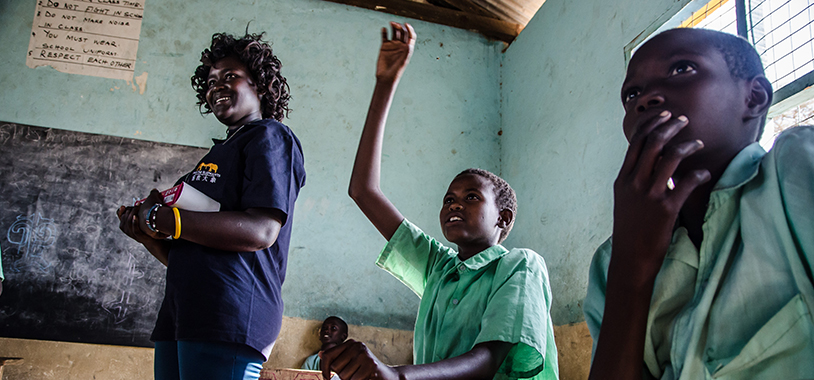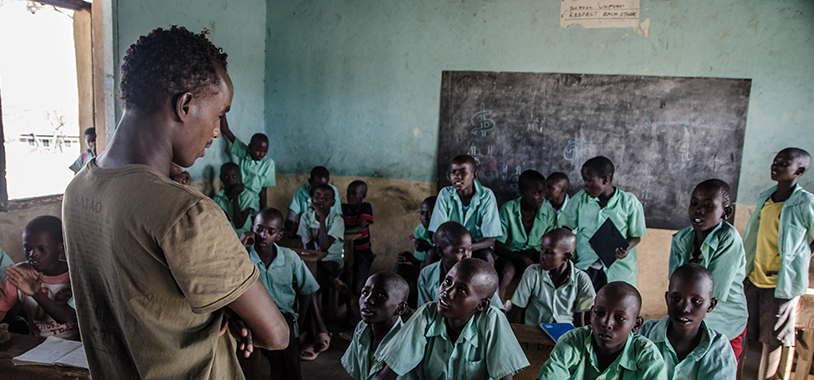Here in Samburu, we had the pleasure of hosting a few members of the Nairobi community outreach and education team in camp for the last week who are visiting primary schools in the area as part of Save the Elephants’ community outreach programs. STE takes community outreach and education extremely seriously and has pinpointed schools and communities that lie close to or within elephant corridors. Engaging children in interactive learning about elephants, their ecological roles, and their similarities to humans is integral to forming long-term conservation attitudes in villages and communities where elephants can often be a detriment to livestock or crops. I’d hoped that I would get to attend one of these outreach visits during my time with STE and I got just that chance.
After a quick lunch, I joined Daud, one of the education outreach leads here in Samburu and the two interns from Nairobi, Nancy and Consolata for the drive to Lorubae, the primary school that sits right on the border of Samburu National Reserve near the town of Archer’s Post. I was a tad bit nervous, not knowing exactly what to expect. The lesson is entirely in Swahili (of which I know enough nouns to get me through good morning, breakfast, dinner, and a handful of verbs that basically make me sound like a two-year-old) and thus I knew I wouldn’t necessarily understand everything that was being said. But it turned out that language is only so much of a barrier.
We arrived at the school at around three in the afternoon to a raucous welcome. I don’t think I’ve ever seen kids so excited. Green smocks abounded as children ranging from kindergarten to eighth grade excitedly ran to our car full of polite “jambos.” Daud is a version of a local celebrity because he helps run nature documentary screenings in this school and many children ran up to him to say hello and give him a hug. Along with Daud, Nancy and Consolata make up a stellar team of young Kenyans who carry out these lessons. Armed with a bag containing a poster of an elephant, a plastic cast of an elephant molar, several dried dung balls, and a box full of chocolate treats, the team was ready.
With a grace and enthusiasm that I’ve rarely seen in educators, the three teamed up to get the attention of the sixth grade class as the kids stuffed themselves into wooden desks. Children from other grades crowded into the windows and doorway hoping for a peak of the lesson but were shepherded away by their instructors – they had to wait their turn. Nancy began the lesson by asking the children what they already knew about elephants – an engagement technique that immediately got all of them excited and rearing to participate. After several students shared their knowledge, they were asked to gather into small groups where they were handed a photograph of elephants interacting and asked to decide as a group what was happening. I meandered around the classroom watching the kids talk excitedly in their groups about their photograph, obviously thinking quite hard about how to explain the elephant interactions. Discussions were had, decisions were made. Members of each group were then asked to present to the class their ideas with corrections or additions made by Daud and Nancy. While the mini presentations were in Swahili, the eloquence of the students who spoke about what was happening between the elephants in the photographs was incredibly inspiring. Each presentation was finished by a group clap of appreciation – something that I think should be incorporated into every primary school class in the U.S.
A variety of other activities including a description of elephant anatomy and a question-and-answer session involving dried elephant dung as a tool for discussing elephants’ role as an ecosystem engineer helped to propel the class along as excited voices continued to fill the small room. The final portion of the lesson involved the answering of elephant trivia questions for small chocolate rewards – sparking a drive to express knowledge that only candy can elicit. Daud’s smiles at the children and their attentiveness and adoration were all full of the same soft, excited quality. This was the future of elephant conservation happening right in this little room before my eyes.
Wrapping the lesson up, Nancy gave the students their assignment. They were all required to go home and speak with their parents about what they’d learned as well as poll them on their attitudes and knowledge of elephants. With that knowledge they’d be required to write a small essay about their findings, ideally solidifying the lesson for them and helping to spread education and appreciation for elephants to adults.
It’s this kind of holistic approach to elephant conservation that makes Save the Elephants a truly gold-star organization. As conservation and communities struggle to find balance throughout much of Sub-Saharan Africa, STE is working hard to create spaces for the next generation to treasure and respect their natural resources. And if today’s lesson was any indication of the kind of enthusiasm that these kinds of outreach programs can inspire, well, let’s just say I’m feeling pretty hopeful about the future.



